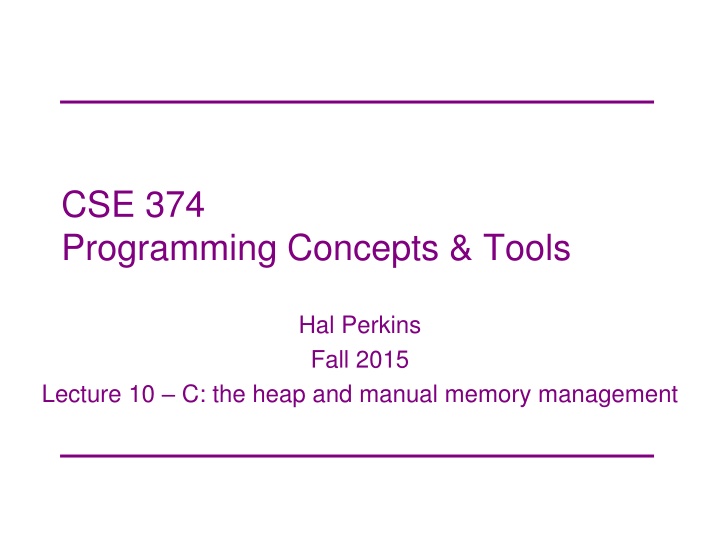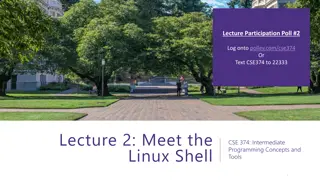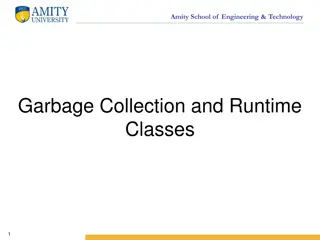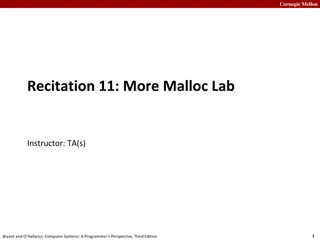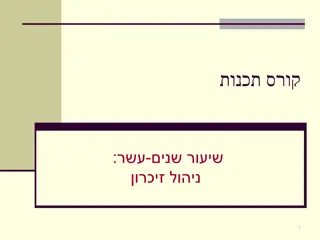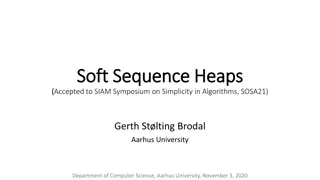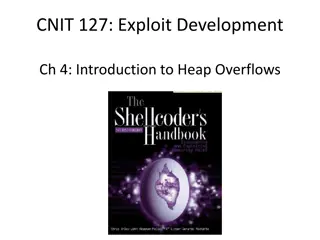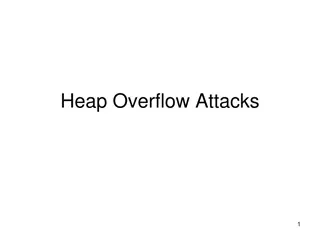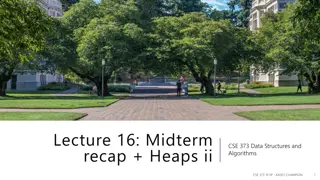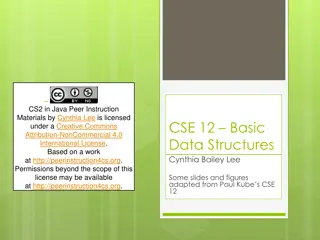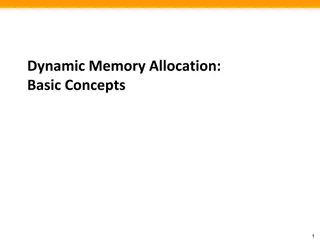CSE 374 Programming Concepts & Tools - Lecture on C Heap and Memory Management
In this lecture by Hal Perkins, the focus is on the heap and manual memory management in the C programming language. Discussions cover concepts like pointer syntax, heap allocation, and the use of malloc function. Key points include differences between stack and heap allocation, usage of malloc to allocate memory on the heap, and essential considerations for manual memory management in C.
Download Presentation

Please find below an Image/Link to download the presentation.
The content on the website is provided AS IS for your information and personal use only. It may not be sold, licensed, or shared on other websites without obtaining consent from the author.If you encounter any issues during the download, it is possible that the publisher has removed the file from their server.
You are allowed to download the files provided on this website for personal or commercial use, subject to the condition that they are used lawfully. All files are the property of their respective owners.
The content on the website is provided AS IS for your information and personal use only. It may not be sold, licensed, or shared on other websites without obtaining consent from the author.
E N D
Presentation Transcript
CSE 374 Programming Concepts & Tools Hal Perkins Fall 2015 Lecture 10 C: the heap and manual memory management
Administrivia Midterm exam Monday(!) Topics everything up to hw4 (including gdb) These slides (malloc) are for next hw and final Old exams on web now for review Review Q&A Sunday. 1pm (SAV 264?) Remember to switch to standard time 2am Sun. HW4 reminders (Re-)read the specifications (assignment) carefully clint: pay attention to most everything; questions, about edge cases, odd warnings, etc.? Discussion board Watch late days several people have used up all but 1 already and a couple of people are out(!) Gradebook entry gives number we think you have left 2
Pointer syntax A review (for completeness) Declare a variable to have a pointer type: T * x; or T* x; or T *x; or T*x; (where T is a type and x is a variable) An expression to dereference a pointer: *x (or more generally *e) where e is an expression C s designers used the same character on purpose, but declarations (create space) and expressions (compute a value) are totally different things 3
Heap allocation So far, all of our ints, pointers, and arrays, have been stack-allocated, which in C has two huge limitations: The space is reclaimed when the allocating function returns The space required must (normally) be a constant (only an issue for arrays) Heap-allocation has neither limitation Comparison: new T(...) in Java does all this: Allocate space for a T (exception if out-of-memory) Initialize the fields to null or 0 Call the user-written constructor function Return a reference (hey, a pointer!) to the new object And the reference has a specific type: T In C, these steps are almost all separated 4
malloc, part 1 malloc is just a library function: it takes a number, heap-allocates that many bytes and returns a pointer to the newly-allocated memory Returns NULL on failure Does not initialize the memory You must cast the result to the pointer type you want You do not know how much space different values need! Do not do things like malloc(17) ! 5
malloc, part 2 malloc is always used in a specific way: (T*)malloc(e * sizeof(T)) Returns a pointer to memory large enough to hold an array of length e with elements of type T It is still not initialized (use a loop)! Underused friend: calloc (takes e and sizeof(T) as separate arguments, initializes everything to 0) malloc returns an untyped pointer (void*); the cast (T*) tells C to treat it as a pointer to a block of type T If allocation fails (extremely rare, but can happen), returns NULL. Programs must always check. 6
Half the battle We can now allocate memory of any size and have it live forever For example, we can allocate an array and use it indefinitely Unfortunately, computers do not have infinite memory so living forever could be a problem Java solution: Conceptually objects live forever, but the system has a garbage collector that finds unreachable objects and reclaims their space C solution: You explicitly free an object s space by passing a pointer to it to the library function free Freeing heap memory correctly is very hard in complex software and is the disadvantage of C-style heap- allocation 7
Everybody wants to be free(d once) int * p = (int*)malloc(sizeof(int)); p = NULL; /* LEAK! */ int * q = (int*)malloc(sizeof(int)); free(q); free(q); /* HYCSBWK */ int * r = (int*)malloc(sizeof(int)); free(r); int * s = (int*)malloc(sizeof(int)); *s = 19; *r = 17; /* HYCSBWK, but maybe *s==17 ?! */ Problems much worse with functions: f returns a pointer; (when) should f s caller free the pointed-to object? g takes two pointers and frees one pointed-to object. Can the other pointer be dereferenced? 8
The Rules For every run-time call to malloc there should be one run- time call to free If you lose all pointers to an object, you can t ever call free (a leak)! If you use an object after it s freed (or free it twice), you used a dangling pointer! Note: It s possible but rare to use up too much memory without creating leaks via no more pointers to an object Interesting side-note: The standard-library must remember how big the object is (but it won t tell you) We will explore this further later . 9
Valgrind Ideally there are no memory leaks, dangling pointers, or other bugs, but how do we check? valgrind program program-arguments Runs program with program-arguments Catches pointer errors during execution At end, prints summary of heap usage, including details of any memory leaks at termination option --leak-check=full provides more details use it But it really slows down execution But still a fantastic diagnostic, debugging tool Valgrind has other options/tools but memory check is the default and most commonly used 10
Processes and the heap Recall: a process (running program) has a single address space (code, static/global, heap, stack) When a program terminates the address space is released by the OS So any allocated memory is reclaimed since it no longer exists Good practices OK to rely on this if appropriate, but Any data structure package that allocates storage should normally provide routines to free it so client code can release the space if the client wants to 11
